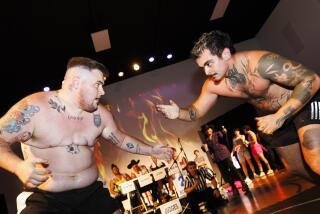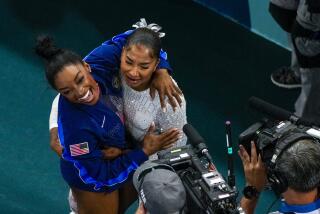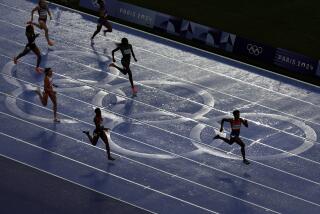Pioneers Still See Room to Improve
They watched dreamily as videotape reeled off their accomplishments and triumphs. They beamed as they walked through the luncheon crowd to accept sculptured-glass awards. They smiled for an appreciative audience that included Olympians who’d competed as far back as 1936.
But when asked about the rates of progress in the sports in which they’d made their reputations more than 20 years ago, Gwen Adair, Lucia Rijker, Lilly Rodriguez and Shannon Williams Yancey had to pause and take stock.
They were among six women honored by the Amateur Athletic Foundation of Los Angeles Thursday on National Girls and Women in Sports Day for their athletic contributions. A fifth honoree, weightlifter and bodybuilder Abbye “Pudgy” Stockton, was unable to attend the presentation. Also feted was Dusty Chapman, a longtime volunteer whose service goes back to the 1984 Olympics.
Adair, Rijker, Rodriguez and Yancey were all pioneers in what are considered nontraditional sports for women. Rijker and Rodriguez were professional kickboxers and boxers. Rijker still competes, and Rodriguez is now a trainer.
Adair was the first woman to referee a men’s world championship fight. Yancey is the most decorated female amateur wrestler in U.S. history and the first female high school wrestling coach in state history. They all understand that pioneers don’t always reap big rewards.
Still, Rijker and Rodriguez believe their sport should be on a grander scale.
“I think female boxing is doing well in the broad sense, because, worldwide, lots of women are taking up the sport and competing,” said Rijker, who has won four kickboxing titles, two boxing titles and is undefeated in both sports.
“But the media hasn’t jumped on the athletes, it’s jumped on the celebrities, the ‘pretty’ girls. In tennis, that Russian girl [Anna Kournikova] is making more money than anyone, and she hasn’t won anything. It’s kind of similar in boxing; it’s the look that sells.... The moment they can make us [a sex] object in the sport, that’s gonna happen.”
Rodriguez, who won two titles in the 1980s, states a similar case.
“Nobody believed in us, or me, at first,” she said. “They thought it would be ‘foxy boxing.’ But I didn’t go in there wanting to show anything other than my skills in boxing. Now I wish we had pushed harder for the women then and got the ball rolling. Our sport should be much bigger than it is.”
Record-keeping in pro boxing for women is spotty at best. One organization, the New Jersey-based Assn. of Boxing Commissions, estimated in 2002 that there were 250 to 300 pro female boxers around the world based on fighters with at least three recorded decisions in sanctioned bouts. There are thousands of pro male boxers.
But there are lots more female fighters than female boxing officials. The association estimates there are fewer than 20 women licensed as referees or judges.
“There was a lot of resistance coming in,” said Adair, who began her refereeing career in the late 1970s. “I realized [refereeing] was like invading a male-dominated sport.
“Because there is resistance, a person who wants to do this really has to make up their mind that they’re going to hang in there: ‘I know if I’m qualified and they allow me to prove myself I can be good.’ You have to realize you’ll be under scrutiny; they’ll watch everything you do. That’s the way it was for me and I’ve seen it with other women who want to be judges.”
Yancey, a four-time national champion who also won 13 medals in international events, can point to more progress in wrestling.
According to a 2002-03 survey taken by National Federation of State High School Assns., there were 3,769 girls in the sport, and the 805 high schools responding to the national survey said at least one female wrestled on their varsity teams. That’s a jump from five years ago, when the survey yielded a total of 1,907 female wrestlers and 619 schools with at least one girl on the varsity.
“Girls’ wrestling is definitely a growing sport,” said John Gillis, an assistant director at the national federation.
Even though the NCAA does not sanction wrestling as a sport for women, six colleges have women’s teams. The biggest weight class, according to USA Wrestling, is 158.5 pounds.
And women’s wrestling will be in the 2004 Olympic Games this summer in Athens.
“Back when I was going to school, we had no college opportunity, no scholarships,” Yancey said. “The first time they sent [the women’s national team] to a world championship, USA Wrestling gave us cotton sweats to wrestle in.
“And now it will be an Olympic sport, and there is funding for everything they do. So each year it has gotten better, from scholarships to apparel. It really has come a long way.”
Yet Yancey said more could have happened.
“If you look at other countries, women’s wrestling is very developed, with depth in every weight class. And my disappointment -- if it had been in the Olympics four years ago, I think I could have been there. What I’m going to love ... is when girls start seeing it on TV. Right now, a lot of young girls still don’t know wrestling exists for them.”
Foundation President Anita DeFrantz, who presided over the award ceremony, understands the feelings of frustration.
“You saw the women today; they’re beautiful,” DeFrantz said. “The difference is the idea of acceptance. It is as though men are afraid that because a woman can box, well, ‘Could I beat her?’ Maybe not. Just as Sugar Ray Leonard could not have beaten Muhammad Ali. There are differences.
“You don’t have to be the same to be equal. And it’s my goal to help people understand that equal is what equal is, but women and men are not the same.
“Yet they should have equal opportunities. Sports belong to us all.”
More to Read
Go beyond the scoreboard
Get the latest on L.A.'s teams in the daily Sports Report newsletter.
You may occasionally receive promotional content from the Los Angeles Times.










